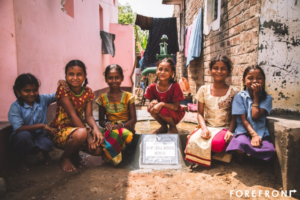“What will your students remember in five years?” was a question asked during one of our professional learning sessions with Transforming Education. Usually when you recall a memory, you associate it with a certain emotion – whether that is happiness, sadness, excitement, or anger. When building lessons for our novels this year, I wanted to focus on that question in my 7th grade English class. What will my students remember from this? What could I teach that would build a deeper connection to their own emotions? That is how I came up with this unexpected yet rewarding experience.
The instructional literature practice of our most recent unit focused on the in-class novel, The Red Pencil by Andrea Davis Pinkney. The novel centers on a young girl who lived through the Darfur genocide in a refugee camp. Later, she found her own hopes, dreams, and desire to attain an education despite her circumstances. The 7th grade team and I had to identify and grasp the deep topics that were represented in this novel. The most important aspect that pierced us was our empathy for the many groups of people who face oppression on a daily basis. Not only did our students need to know how people lived, but they also needed to understand that around the world, many people face inequality of gender, education, lack of clean water, and medication.
To deepen students’ understanding of social awareness, I asked them to research topics of inequality to empathize with the oppressed across the world. We also watched a Netflix documentary called Tales by Light so my students could grapple with the perspective of people who had their basic needs stripped away. One episode showed images of children around their age having to live in circumstances that no one could imagine. Yet, this was not enough. It was not enough to find statistics on how many people were diseased from the water they drank or how many miles girls had to walk to get water for their families. The 7th grade teachers and I felt compelled to do more than just sit in our seats and ask students to look at their screens to understand what people are going through. So, we started a project with a non-profit organization called FOREFRONT, a charity mission that believes in establishing self-sustaining communities through clean water, education, medical care, and women’s empowerment. Through this organization, our 7th grade students raised $1,257, more than the amount needed, to build a clean water source in India for an entire village.

When the money was donated, the FOREFRONT team went to India to build the well. It truly became an eye-opening experience when we received pictures and videos of the water well in India with our school’s name on it. This experience gave students a chance to feel excited, happy, and confident in themselves. It opened a new desire to make a difference and increased their social awareness, perspective taking, and empathy.

As a new teacher, I constantly ask myself: Am I doing this right? Am I doing enough? Are they learning what I’m supposed to be teaching? This project gave me exactly what I needed: confidence to believe that I was doing something right and something good. My students learned to empathize and have compassion for people whom they have never met. In the process, I helped pave the way for my students to make a difference in society. And that is just enough for them to remember this moment in five years.


